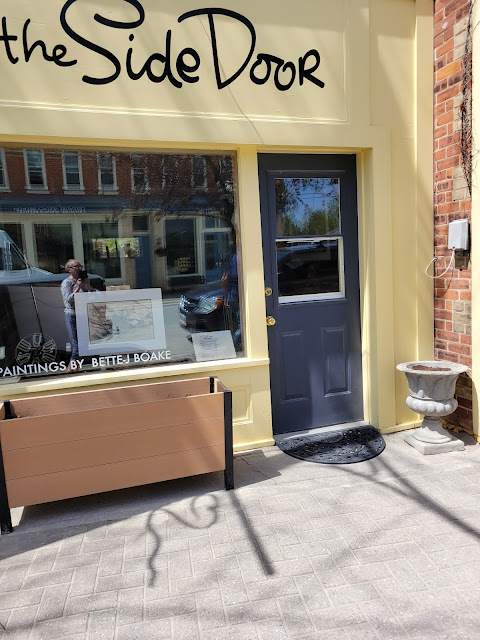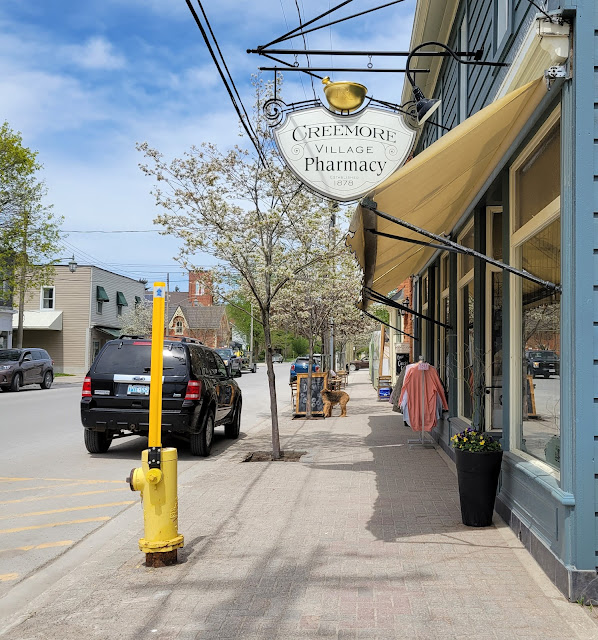Day 6 Creemore ON
May 2022 - Creemore ON
Creemore was settled in 1842 and the town has strong Irish roots. The name Creemore comes from the Gaelic ‘croí mór’ which mean big heart. This is present in how the founder, Irish entrepreneur Edward Webster, honored his family by naming the streets after them. But Creemore has older roots. Samuel de Champlain visited the area in 1616 while promoting trade with the First Nation’s tribe Petun.The village was a bustling farming community in the 1880s, when it had 700 residents, three hotels and several mills powered by water from Mad River. It even had a small jail.
The Toronto, Barrie and Collingwood railway was close by and in 1889 the Hamilton and Northwest Railway brought trains right to the village.
Lumber, hogs and farm produce from the area were sent by rail to city markets.
S
They also shipped live hogs on the local railway, known as the Hog Special. Two of his sons, Sam and Jacob, grew the business under the moniker of S & J Hisey.
1878 to 1909 William J. Corbett
They say that W.J. Corbett moved his pharmacy up the road in a wheelbarrow from the village of Avening to the Gowan’s hotel in Creemore. In 1880, he moved a few steps further north to the current location, where the pharmacy remains today.
W.J.’s son, Milton Corbett joined his father following his registration with the Ontario College of Pharmacists in 1909 to form W.J. Corbett & Son. During his distinguished career, he was a Registrar of the Ontario College of Pharmacy and President of the Canadian Pharmaceutical Association.
This sculpture was hidden behind some construction hoarding. Sculpture is by artist Ralph Hicks and called Dress up Dance.
The Hiseys were certainly an enterprising family. This plaque is located beside the 100 Mile Store.
Bob Ransier has in his home a piece of Creemore’s history.He has built into the wall of his living room the original safe from the Hisey Company, which had their main office at 176 Mill Street, now the location of Creemore 100 Mile Store.
When he first acquired the safe from Anne Scott, Ransier had to hire a locksmith to get it open. Ransier and Scott agreed to split whatever money was inside.
Once the locksmith drilled open the safe, it was discovered it contained 59 cents and a Columbian penny. That handful of change is still tucked away in the safe, neither of them having gone running to the bank.
Ransier said there is no manufacturer, serial number or identifying marks on the safe, but he is interested in learning more about it. He does know it once belonged to the Hiseys, who had a farm on Ten Hill and a butcher shop in town.
Another brother, John Hisey, opened a brickyard, which supplied much of the bricks used to construct the main street buildings.
Mill House Pub was our lunch destination.
In 1910 the cabin was rented by Joseph Veitch, a widower with two daughters. One daughter, Hazel, married Robert Shaw and the Shaw family continued to live in the cabin. Eventually their son Marlyn became the sole occupant until he went to the Creedan Valley Nursing Home in 2004.
On our way back we drove through Wasaga Beach, we had intentions to stop but nothing about the town called to us with its strips of motels and fast food chains.
Located on the south shore of Georgian Bay, in the inlet of Nottawasaga Bay, its most famous feature, not surprisingly, is its namesake, Wasaga Beach. Soft, sandy shoreline stretching 14 km makes Wasaga Beach the longest freshwater beach in the world, and one of Ontario's most beloved beachy destinations.
















.jpg)







No comments:
Post a Comment
This blog does not allow anonymous comments.